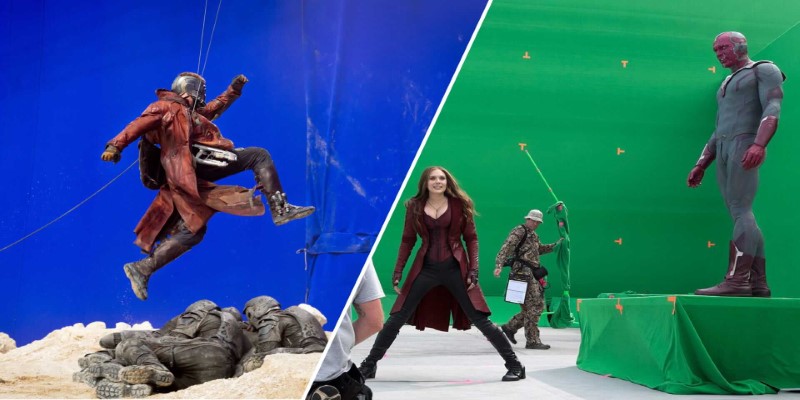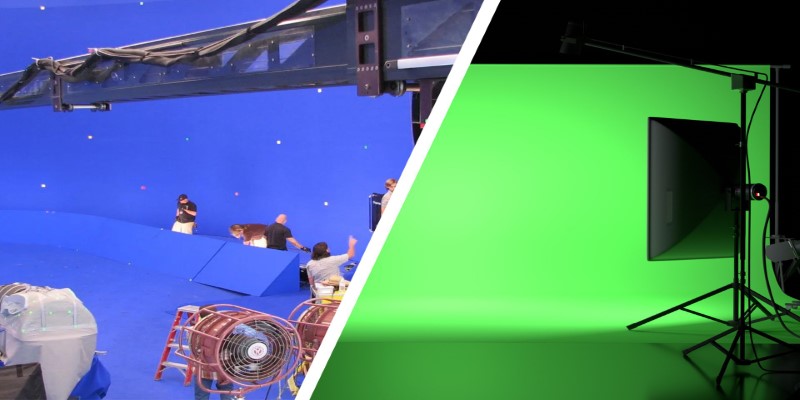In the dynamic realm of film and video production, the selection between blue and green screens significantly influences the creation of compelling visuals. These screens act as essential backdrops throughout filming, allowing editors to seamlessly substitute the initial background with diverse scenes in post-production.
Delving deeper, let's explore the multifaceted applications and unique characteristics that set apart blue and green screens, unraveling the key distinctions filmmakers consider when embarking on their visual storytelling journey.
The traditional blue screen, frequently glimpsed in behind-the-scenes footage, serves the crucial purpose of isolating the subject from its surroundings. Its rich, deep blue shade establishes a pronounced contrast, facilitating video editing software in accurately discerning and substituting the blue backdrop.
This technique, recognized as chroma keying, empowers filmmakers to seamlessly transport their characters to various locations during post-production. The distinct advantage of the classic blue screen lies in its ability to create a clear distinction, ensuring a smooth and effective chroma key process for filmmakers aiming to weave captivating narratives against diverse and dynamic backgrounds.
In recent years, the green screen has surged in popularity due to its distinct post-production editing advantages. Green screens excel in color separation, particularly when the primary subject incorporates blue elements. This quality proves invaluable during editing, as it facilitates editors in seamlessly extracting and replacing the green background.
The outcome is a refined and precisely rendered visual spectacle, marked by smoother transitions and heightened accuracy in visual effects. The widespread adoption of green screens showcases their efficacy in enhancing filmmaking, providing a versatile tool for content creators to elevate their projects through meticulous post-production work.
In practical applications, filmmakers harness the versatility of blue and green screens to bring diverse visual concepts to life.

When capturing the beauty of outdoor landscapes, filmmakers often opt for blue screens as they harmonize effortlessly with natural lighting conditions. The deep blue backdrop accentuates the scene's authenticity, creating a seamless blend between the subject and the surroundings.
On the flip side, green screens act when the characters don blue attire. This strategic choice prevents any unintended merging of colors during the editing process. Filmmakers delve into the intricacies of the scene's context and color palette, allowing them to make an informed decision on whether the tranquil blue or vibrant green screen will best complement their project.
The realm of television news and virtual sets has undergone a transformative shift with the widespread adoption of green screens. The vividness of the green hue serves as the preferred canvas, offering a stark contrast that enables news anchors to deliver reports against dynamic and interactive digital backgrounds.
This technological innovation has reshaped news presentation, ushering in visually captivating experiences for viewers who now expect a seamless integration of the news anchor and the digital backdrop.
In cinematic enchantment, blue and green screens play instrumental roles in breathing life into fantasy worlds. From ethereal landscapes to cosmic adventures, filmmakers leverage these screens to transport characters to realms born solely from imagination. The adaptability of blue and green screens forms the backbone of cinematic magic, facilitating the creation of awe-inspiring special effects that captivate audiences.
When it comes to showcasing products in advertisements and presentations, the selection between blue and green screens hinges on the inherent colors of the items. Blue screens prove ideal for featuring products with green elements, ensuring a visually pleasing presentation.
Conversely, green screens spotlight items predominantly adorned in blue hues. This meticulous attention to color coordination guarantees a flawless integration of the subject into the carefully chosen background, elevating the overall visual appeal of commercials and product presentations.
In professional settings, blue screens offer a composed backdrop for corporate interviews, conveying a sense of sophistication. Meanwhile, green screens prove beneficial when subjects wear blue attire, ensuring a clean separation during post-production.
This strategic color selection in corporate videos maintains a polished, distraction-free background for virtual meetings or presentations. Filmmakers opt for either blue or green screens based on attire, context, and the desired tone, enhancing the professionalism of visual content in the corporate realm.
When considering utilizing a blue or green screen, filmmakers and content creators delve into a thoughtful analysis of various factors. Paramount among these considerations are the unique requirements of the project, the color palette prevalent in the scene, and the envisioned visual effects. This decision-making process resembles an art form where every detail matters.

The specifics of each project guide the selection between the classic blue screen and the vibrant green counterpart. Filmmakers keenly assess the hues and tones within the scene, ensuring compatibility with the chosen screen. Carefully weighing these elements is not just a technicality but an integral part of the creative process.
Informed choices, rooted in a deep understanding of the project's needs, form the bedrock of successful visual storytelling. Whether transporting characters to fantastical realms or seamlessly integrating subjects into virtual landscapes, the decision between blue and green screens shapes the narrative. The interplay of color, creativity, and technical precision in this decision underscores the dynamic fusion of art and technology in filmmaking.
In visual storytelling, using blue and green screens has become indispensable. From creating fantastical realms to seamlessly integrating virtual sets, these screens open up a world of possibilities for filmmakers. Understanding each screen's practical applications and nuances empowers creators to make informed decisions, ensuring the success of their visual projects. So, whether it's the classic blue or the vibrant green, these screens continue to shape how we experience cinema's magic.

By Susan Kelly/Mar 11, 2024

By Lucy Lee/Apr 25, 2024

By Georgia Vincent/Jun 17, 2025

By Susan Kelly/Feb 25, 2024

By Eleanor/Apr 28, 2024

By Frederica/Mar 25, 2025

By Frederica/Apr 09, 2024

By Eleanor/May 11, 2024

By Kristina Cappetta/Apr 28, 2025

By Triston Martin/Apr 08, 2024
By Frederica/Nov 09, 2024

By Triston Martin/Mar 12, 2024